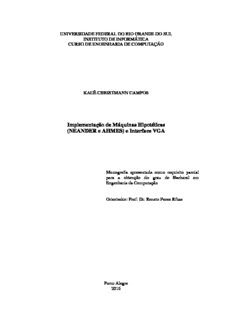
NEANDER e AHMES PDF
Preview NEANDER e AHMES
UNIVERSIDADEFEDERALDORIOGRANDEDOSUL INSTITUTODEINFORMÁTICA CURSODEENGENHARIADECOMPUTAÇÃO KAUÊCHRISTMANNCAMPOS Implementação de Máquinas Hipotéticas (NEANDER e AHMES) e Interface VGA Monografia apresentada como requisito parcial para a obtenção do grau de Bacharel em EngenhariadaComputação Orientador:Prof.Dr.RenatoPerezRibas PortoAlegre 2016 UNIVERSIDADEFEDERALDORIOGRANDEDOSUL Reitor: Prof.RuiVicenteOppermann Vice-Reitora: Profa.JaneFragaTutikian Pró-ReitordeGraduação: VladimirPinheirodoNascimento DiretoradoInstitutodeInformática: Profa.CarlaMariaDalSassoFreitas CoordenadordoCursodeEngenhariadeComputação: Prof.RaulFernandoWeber Bibliotecária-chefedoInstitutodeInformática: BeatrizReginaBastosHaro “It does not matter how slowly you go as long as you do not stop.” — CONFUCIUS AGRADECIMENTOS Aestauniversidade,seucorpodocente,direçãoeadministraçãoquemeoportuni- zaramascondiçõesnecessáriasparaqueeualcançassemeusobjetivos. Ao meu orientador por todo o tempo que dedicou a me ajudar durante este traba- lho. Aosmeuspaispeloamor,ensinamentoeapoio. Emfim, a todos que contribuíram para a realização deste trabalho, seja de forma diretaouindireta,ficaregistradoaqui,omeumuitoobrigado! RESUMO Este trabalho busca fazer uma abordagem didática sobre as diferentes formas de imple- mentação das máquinas hipotéticas (Ahmes e Neander), assim como das linguagens de descrição de hardware (Verilog e VHDL) utilizadas na implementação destas. Também é exposto neste trabalho uma forma de apresentar as arquiteturas desenvolvidas fazendo usodeumkitdedesenvolvimentoFPGAeummonitor. Aindanesteescoposerádescrito um driver para mostrar caracteres de texto ASCII em um monitor VGA com a finalidade de facilitar o uso deste em projetos diversos e também é definida e implementada uma interfacegenérica. Palavras-chave: FPGA.máquinashipotéticas. Ahmes. Neander. Verilog. VHDL.VGA. Implementationofthehypotheticalmachines(NEANDERandAhmes)andVGA interface ABSTRACT This work seeks a didactic approach of the different implementation methods for the hy- pothetical machines (Ahmes and Neander) and the hardware description languages (Ver- ilog and VHDL) that implement these computers. It is also exposed within this work a way of presenting the designed architectures using a FPGA developer kit. Still, in this scope it will be developed a driver for displaying ASCII text characters on the VGA display for the purpose of facilitating its use on a variety of projects and also a generic interfaceisdefinedandimplementedaswell. Keywords: FPGA,hypotheticalmachines,Ahmes,Neander,Verilog,VHDL,VGA. LISTADEABREVIATURASESIGLAS VHDL VHSICHardwareDescriptionLanguage VHSIC VeryHighSpeedIntegratedCircuits FPGA FieldProgrammableGateArray ROM ReadOnlyMemory RAM RandomAccessMemory FSM FiniteStateMachine VGA VideoGraphicsArray LISTADEFIGURAS Figura2.1 MenudeMemória1......................................................................................17 Figura2.2 MenudeMemória2......................................................................................17 Figura2.3 MenudeMemória3......................................................................................18 Figura2.4 MenudeMemória4......................................................................................19 Figura2.5 MenudeMemória5......................................................................................19 Figura2.6 MenudeMemória6......................................................................................20 Figura2.7 MenudeMemória7......................................................................................20 Figura2.8 MenudeMemória8......................................................................................21 Figura2.9 Ciclodeleituradememória...........................................................................23 Figura2.10 Ciclodeescritanamemória........................................................................24 Figura3.1 DiagramadeBlocos.......................................................................................27 Figura3.2 ArquiteturaUCtemporizador........................................................................44 Figura3.3 DiagramadeestadosdaFSMparaROM......................................................46 Figura3.4 DiagramadeestadosdaFSMparaRAM......................................................48 Figura4.1 VarreduradoquadroVGA.............................................................................54 Figura4.2 RestriçõesdetempoH_SYNC......................................................................55 Figura4.3 RestriçõesdetempoV_SYNC......................................................................56 Figura4.4 ArquiteturadriverVGA.................................................................................58 Figura4.5 ArquiteturaGeradordePixels.......................................................................60 Figura4.6 Exemplodedesenhodecaractere((CHU,2008))..........................................61 Figura5.1 Arquiteturadivisordefrequências.................................................................65 Figura5.2 Simulaçãododivisordefrequências.............................................................66 Figura5.3 FrequênciadeH_SYNCnoosciloscópio......................................................68 Figura5.4 FrequênciadeV_SYNCnoosciloscópio......................................................69 Figura5.5 DemonstraçãoprojetoVGAgenériconomonitor.........................................69 Figura5.6 DemonstraçãodeAhmesnomonitor............................................................72 LISTADETABELAS Tabela3.1 TabeladeInstruções......................................................................................26 Tabela3.2 Execuçãodasinstruções................................................................................29 Tabela3.3 EstadoseAções.............................................................................................47 Tabela3.4 EstadoseAções.............................................................................................49 Tabela4.1 ResoluçõesesuasEspecificações..................................................................57 SUMÁRIO 1INTRODUÇÃO...........................................................................................................11 1.1 Motivação.................................................................................................................12 1.2 Objetivo....................................................................................................................12 1.3 Estrutura..................................................................................................................12 2MEMÓRIA..................................................................................................................14 2.1 MemóriaROM........................................................................................................14 2.2 MemóriaRAM........................................................................................................16 2.2.1 ImplementaçãoviaFerramenta..............................................................................16 2.2.2 ImplementaçãoViaInferênciaaoCompilador......................................................21 2.2.3 SimulaçãodeFuncionamento................................................................................23 3MÁQUINASHIPOTÉTICAS....................................................................................25 3.1 TabeladeInstrucções..............................................................................................25 3.2 Arquitetura..............................................................................................................27 3.3 ExecuçãodasInstruções.........................................................................................27 3.4 ImplementaçãodeBlocosdaArquitetura............................................................29 3.4.1 PC...........................................................................................................................30 3.4.2 REM,RDM,RI,ACeRegistradordeEstados......................................................32 3.4.3 MUX......................................................................................................................35 3.4.4 Decodificador.........................................................................................................36 3.4.5 ULA.......................................................................................................................39 3.5 UnidadesdeControle.............................................................................................43 3.5.1 UnidadesdeControleparaROM...........................................................................43 3.5.1.1 Temporizador......................................................................................................43 3.5.1.2 FSM....................................................................................................................45 3.5.2 UnidadesdeControleparaRAM...........................................................................47 3.5.2.1 Temporizador......................................................................................................47 3.5.2.2 FSM....................................................................................................................48 3.6 SimulaçãoTestbench...............................................................................................49 3.7 EmpacotadordeMemória.....................................................................................52 4VGA(VIDEOGRAPHICSARRAY)........................................................................54 4.1 EspecificaçõesVGA.................................................................................................54 4.2 ArquiteturaDriverVGA........................................................................................57 4.3 ControleVGA..........................................................................................................58 4.3.1 SinaisdeSincronização.........................................................................................58 4.3.2 RequerimentodePixel...........................................................................................59 4.4 GeradordePixels....................................................................................................60 4.4.1 MemóriadeCaracteres..........................................................................................60 4.4.2 MemóriadeTela....................................................................................................61 4.4.3 Funcionamento.......................................................................................................62 5PROJETOVGAGENÉRICO...................................................................................64 5.1 InterfaceeDriverVGA..........................................................................................64 5.1.1 DivisordeFrequências..........................................................................................64 5.1.2 Interface.................................................................................................................66 5.2 ProjetoVGA............................................................................................................67 5.3 ComputadoresHipotéticosnoMonitor................................................................70 6CONCLUSÃOESUGESTÕESPARATRABALHOSFUTUROS.......................73 REFERÊNCIAS.............................................................................................................74 7APÊNDICE..................................................................................................................75
Description: